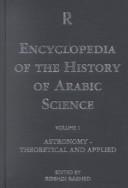
Ḥasan Ibn al-Haytham was a medieval mathematician, astronomer, and physicist of the Islamic Golden Age from present-day Iraq. Referred to as "the father of modern optics", he made significant contributions to the principles of optics and visual perception in particular. His most influential work is titled Kitāb al-Manāẓir, written during 1011–1021, which survived in a Latin edition. The works of Alhazen were frequently cited during the scientific revolution by Isaac Newton, Johannes Kepler, Christiaan Huygens, and Galileo Galilei.
Thābit ibn Qurra ; 826 or 836 – February 19, 901, was a polymath known for his work in mathematics, medicine, astronomy, and translation. He lived in Baghdad in the second half of the ninth century during the time of the Abbasid Caliphate.
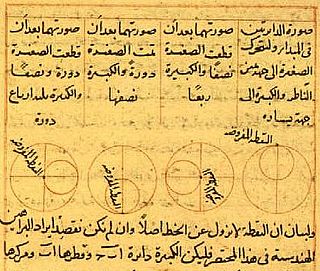
Science in the medieval Islamic world was the science developed and practised during the Islamic Golden Age under the Abbasid Caliphate of Baghdad, the Umayyads of Córdoba, the Abbadids of Seville, the Samanids, the Ziyarids and the Buyids in Persia and beyond, spanning the period roughly between 786 and 1258. Islamic scientific achievements encompassed a wide range of subject areas, especially astronomy, mathematics, and medicine. Other subjects of scientific inquiry included alchemy and chemistry, botany and agronomy, geography and cartography, ophthalmology, pharmacology, physics, and zoology.
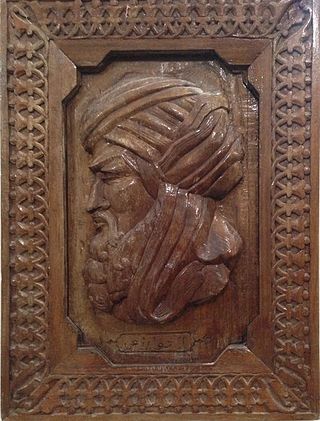
Muhammad ibn Musa al-Khwarizmi, often referred to as simply al-Khwarizmi, was a Persian polymath who produced vastly influential Arabic-language works in mathematics, astronomy, and geography. Hailing from Khwarazm, he was appointed as the astronomer and head of the House of Wisdom in the city of Baghdad around 820 CE.

Kamal al-Din Hasan ibn Ali ibn Hasan al-Farisi or Abu Hasan Muhammad ibn Hasan ) was a Persian Muslim scientist. He made two major contributions to science, one on optics, the other on number theory. Farisi was a pupil of the astronomer and mathematician Qutb al-Din al-Shirazi, who in turn was a pupil of Nasir al-Din Tusi.
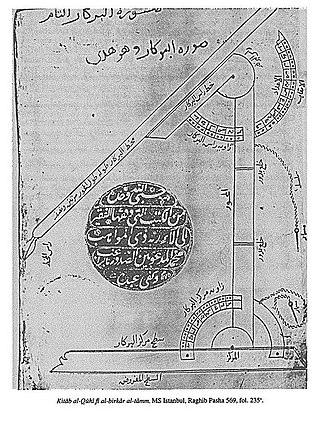
Abū Sahl Wayjan ibn Rustam al-Kūhī was a Persian mathematician, physicist and astronomer. He was from Kuh, an area in Tabaristan, Amol, and flourished in Baghdad in the 10th century. He is considered one of the greatest geometers, with many mathematical and astronomical writings ascribed to him.
Sharaf al-Dīn al-Muẓaffar ibn Muḥammad ibn al-Muẓaffar al-Ṭūsī known more often as Sharaf al-Dīn al-Ṭūsī or Sharaf ad-Dīn aṭ-Ṭūsī, was an Iranian mathematician and astronomer of the Islamic Golden Age.
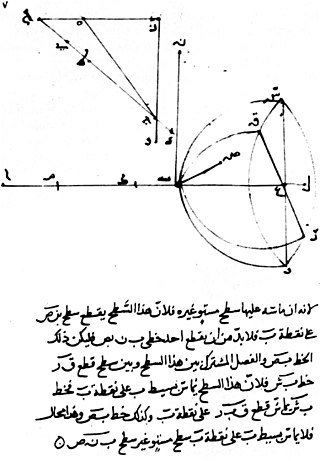
Ibn Sahl was a Persian mathematician and physicist of the Islamic Golden Age, associated with the Buyid court of Baghdad. Nothing in his name allows us to glimpse his country of origin.

Optics began with the development of lenses by the ancient Egyptians and Mesopotamians, followed by theories on light and vision developed by ancient Greek philosophers, and the development of geometrical optics in the Greco-Roman world. The word optics is derived from the Greek term τα ὀπτικά meaning 'appearance, look'. Optics was significantly reformed by the developments in the medieval Islamic world, such as the beginnings of physical and physiological optics, and then significantly advanced in early modern Europe, where diffractive optics began. These earlier studies on optics are now known as "classical optics". The term "modern optics" refers to areas of optical research that largely developed in the 20th century, such as wave optics and quantum optics.
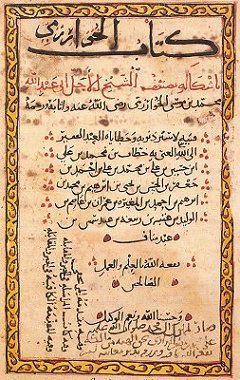
Mathematics during the Golden Age of Islam, especially during the 9th and 10th centuries, was built on Greek mathematics and Indian mathematics. Important progress was made, such as full development of the decimal place-value system to include decimal fractions, the first systematised study of algebra, and advances in geometry and trigonometry.

A sand bath is a common piece of laboratory equipment made from a container filled with heated sand. It is used to evenly heat another container, most often during a chemical reaction.
The following timeline lists the significant events in the invention and development of the telescope.
The word chemistry derives from the word alchemy, which is found in various forms in European languages. Alchemy derives from the Arabic word kimiya (كيمياء) or al-kīmiyāʾ (الكيمياء). The Arabic term is derived from the Ancient Greek χημία, khēmia, or χημεία, khēmeia, 'art of alloying metals', from χύμα, from χέω . However, the ultimate origin of the word is uncertain. According to the Oxford English Dictionary, al-kīmiyāʾ may be derived from the greek "χημία", which is derived from the ancient Egyptian name of Egypt, khem or khm, khame, or khmi, meaning "blackness", i.e., the rich dark soil of the Nile river valley. Therefore, alchemy can be seen as the "Egyptian art" or the "black art". However, it is also possible that al-kīmiyāʾ derived from χημεία, meaning "cast together".
Medieval Islamic geography and cartography refer to the study of geography and cartography in the Muslim world during the Islamic Golden Age. Muslim scholars made advances to the map-making traditions of earlier cultures, particularly the Hellenistic geographers Ptolemy and Marinus of Tyre, combined with what explorers and merchants learned in their travels across the Old World (Afro-Eurasia). Islamic geography had three major fields: exploration and navigation, physical geography, and cartography and mathematical geography. Islamic geography reached its apex with Muhammad al-Idrisi in the 12th century.
The Arab, Arabic, or Arabian mile was a historical Arabic unit of length. Its precise length is disputed, lying between 1,800 metres (5,900 ft) and 2,000 metres (6,600 ft). It was used by medieval Arab geographers and astronomers. The predecessor of the modern nautical mile, it extended the Roman mile to fit an astronomical approximation of 1 minute of an arc of latitude measured along a north–south meridian. The distance between two pillars whose latitudes differed by 1 degree in a north–south direction was measured using sighting pegs along a flat desert plane.
The natural sciences saw various advancements during the Golden Age of Islam, adding a number of innovations to the Transmission of the Classics. During this period, Islamic theology was encouraging of thinkers to find knowledge. Thinkers from this period included Al-Farabi, Abu Bishr Matta, Ibn Sina, al-Hassan Ibn al-Haytham and Ibn Bajjah. These works and the important commentaries on them were the wellspring of science during the medieval period. They were translated into Arabic, the lingua franca of this period.
Roshdi Rashed, born in Cairo in 1936, is a mathematician, philosopher and historian of science, whose work focuses largely on mathematics and physics of the medieval Arab world. His work explores and illuminates the unrecognized Arab scientific tradition, being one of the first historians to study in detail the ancient and medieval texts, their journey through the Eastern schools and courses, their immense contributions to Western science, particularly in regarding the development of algebra and the first formalization of physics.
Kimia is an Ancient Greek word and a feminine given name in Persian language. It means elixir of life, alchemy, or the philosopher’s stone. In ancient Persian poetry, kimia means "rare" or "unique."
Fakhr al-Din al-Akhlati, was a Kurdish and Islamic astronomer from Anatolia, who worked at the Maragha observatory. He was one of the first elites that the Persian polymath Nasir al-Din al-Tusi recruited to work in there. Al-Akhlati's life was in a period contemporaneous with the fall of Baghdad at the hands of the Mongols in 1258.
